Study of High-Temperature Properties of Asphalt Mixtures Used for Bridge Pavement with Concrete Deck
Abstract
1. Introduction
2. Materials and Methods
2.1. Materials and Mix Design
- Amount of mineral material crushed sand 0.063/2 (three levels: 12%, 23%, 34%).
- Ratio of coarse 8/11 to fine grit 2/8 (three levels: 0.3; 1.0; 1.7).
- Binder content (three levels: 5%; 6%; 7%).
2.2. Testing Methods
- is the cumulative axial strain of the test specimen after n loading cycles,
- is the cumulative permanent deformation of the test specimen after n loading cycles,
- is the initial thickness of the specimen.
- is the creep rate,
- ; is the cumulative axial strain of the test specimen after ; loading cycles,
- ; are the repetitive loading cycles.
3. Results
3.1. Results of Permanent Deformation Resistance Test
3.2. Test Results for Air Void Content in an Asphalt Mix
3.3. Test Result Variation Analysis
3.4. Functional Relationships for Describing the Resistance of Asphalt Mixes to Permanent Deformations by Cyclic Compression Test
- is cumulative axial strain,
- is creep rate.
- is binder content,
- is sand fraction content.
- Predetermining the asphalt mix composition based on applicable technical requirements.
- Assessing the resistance of the adopted mix to permanent deformation according to the obtained equations, namely, the cumulative axial strain model and creep rate model, with composition correction—taking into account the limit values for different traffic load categories.
- Assessing the air void content in the designed asphalt mix, together with composition correction—taking into account the limit value for air void content.
- Final assessment of mix resistance to permanent deformation as per developed models.
4. Conclusions
- Asphalt bridge pavement is subjected to specific working conditions relative to pavements located on the ground and requires a different approach to modeling the structural layer asphalt mix composition—the protective layer in particular.
- The state of the art shows that designing the composition of mixtures for protective layers does not take into account the specific working conditions and the function that this layer must perform in the bridge pavement.
- For the protective layers, compactable mineral-asphalt mixtures with a grain size corresponding to the SMA and AC mixtures with an increased binder content are commonly used.
- Asphalt pavement on bridge structures with a concrete deck are particularly exposed to the formation of damage in the form of permanent deformations or ruts.
- The required high waterproofing of bridge pavements achieved through low air void content and increasing protective layer binder content additionally affects the susceptibility of such pavements to the formation of strains, especially under high operating temperatures.
- It is possible to model the high-temperature properties of bridge structure protective layer mixes based on results of cyclic uniaxial compression test.
- The worked-out functional relationships enable the assessment of the resistance to permanent deformations of bridge pavement protective layer asphalt mixes.
- A second-degree functional relationship shall evaluate a protective layer asphalt mix composition in terms of ensuring low air void content (high waterproofing asphalt mixture).
- The developed functional equations enable the selection of asphalt mix composition with high resistance to permanent deformations.
- The developed models make it possible to differentiate the composition of the mixtures in terms of their resistance to permanent deformation in accordance with the cyclic compression test. The models enable the selection of the best parameters of resistance to permanent deformation, taking into account the air void content.
Author Contributions
Funding
Institutional Review Board Statement
Informed Consent Statement
Data Availability Statement
Conflicts of Interest
References
- Asphalt Pavements on Bridge Decks; European Asphalt Pavement Association: Brussels, Belgium, 2013.
- Nicholls, J.C.; Jordan, R.W.; Hassan, K.E. Asphalt Surfacing to Bridge Decks; TRL Report TRL655; SSR Directorate (Highways Infrastructure) Pavement Engineering Team, Highways Agency: Wokingham, UK, 2006. [Google Scholar]
- Radziszewski, P.; Piłat, J.; Sarnowski, M.; Król, J.; Kowalski, K. Nawierzchnie Asfaltowe na Obiektach Mostowych; Oficyna Wydawnicza Politechniki Warszawskiej: Warsaw, Poland, 2016; p. 134. ISBN 978-83-7814-538-7. [Google Scholar]
- Radziszewski, P.; Piłat, J.; Sarnowski, M.; Kowalski, K.; Król, J.; Pokorski, P.; Liphardt, A. Rozwiązania Materiałowo-Technologiczne Izolacji i Nawierzchni Obiektów Mostowych; General Directorate for National Roads and Motorways: Warsaw, Poland, 2013.
- Di Mascio, P.; Loprencipe, G.; Moretti, L.; Puzzo, L.; Zoccali, P. Bridge Expansion Joint in Road Transition Curve: Effects Assessment on Heavy Vehicles. Appl. Sci. 2017, 7, 599. [Google Scholar] [CrossRef]
- Caliendo, C. Stresses and strains prediction model of asphalt pavements on concrete bridges. Int. J. Civ. Eng. Res. 2012, 3, 223–239. [Google Scholar]
- Pokorski, P.; Radziszewski, P.; Sarnowski, M. Odporność na deformacje trwałe asfaltowych nawierzchni mostowych. Czasopismo Inżynierii Lądowej, Środowiska i Architektury. JCEEA 2016, 33, 429–436. [Google Scholar] [CrossRef][Green Version]
- Pokorski, P.; Radziszewski, P.; Sarnowski, M. Fatigue life of asphalt pavements on bridge decks. XXV Polish—Russian—Slovak Seminar Theoretical Foundation of Civil Engineering. Procedia Eng. 2016, 153, 556–562. [Google Scholar] [CrossRef][Green Version]
- Pouget, S.; Sauzeat, C.; di Benedetto, H.; Olard, F. Modeling of viscous bituminous wearing course materials on orthotropic steel deck. Mater. Structores 2012, 45, 1115–1125. [Google Scholar] [CrossRef]
- Medani, T.O.; Scarpas, A.; Kolstein, M.H.; Molenaar, A. Design Aspects for Wearing Coureses on Orthotrpoic Steel Bridge Decks. In Proceedings of the Ninth International Conference on Asphalt Pavements, Copenhagen, Denmark, 17–22 August 2002. [Google Scholar]
- Kim, T.W.; Beak, J.; Lee, H.J.; Lee, S.Y. Effect of pavement design parameters on the behaviour of orthotropic steel bridge deck pavements traffic loading. Int. J. Pavement Eng. 2014, 15, 471–482. [Google Scholar] [CrossRef]
- Journal of Laws, no.63, 735 Regulation of the Minister of Transport and Maritime Economy of 30 May 2000 on Technical Conditions to Be Met by Road Engineering Facilities and Their Location. 18 August 2000. Available online: http://isap.sejm.gov.pl/isap.nsf/DocDetails.xsp?id=wdu20000630735 (accessed on 22 June 2021).
- Nawierzchnie asfaltowe na drogach krajowych WT-2: 2014—Part I Mieszanki Mineralno-Asfaltowe; Wymagania techniczne; General Directorate for National Roads and Motorways: Warsaw, Poland, 2014.
- Kilarski, R. Trwałość nawierzchni ma pomostach drogowych obiektów mostowych. Mater. Bud. 2006, 4, 86–89. [Google Scholar]
- Mieczkowski, P. Warstwy ochronne z mieszanek mineralno-asfaltowych na obiektach mostowych. Izolacje 2012, 17, 54–61. [Google Scholar]
- Gardete, D.; Santos, L.P.; Pais, J. PermanentDeformation Characterization of Bituminous Mixtures using Laboratory Tests. Road Mater. Pavement Des. 2008, 9, 537–547. [Google Scholar] [CrossRef]
- Pasetto, M.; Baldo, N. Influence of the aggregate skeleton designmethod on the permanent deformation resistance of stone mastic asphalt. Mater. Res. Innov. 2014, 18 (Suppl. 3), S3-96–S3-101. [Google Scholar] [CrossRef]
- Remišová, E.; Zatkalíková, V. Evaluation of bituminous binder in relation to resistance to permanent deformation. XXV—Russian—Slovak Seminar Theoretical Foundation of Civil Engineering. Procedia Eng. 2016, 153, 584–589. [Google Scholar] [CrossRef]
- Hafeez, I. Impact of Hot Mix Asphalt Properties on Its Permanent Deformation Behaviour. Ph.D. Thesis, Department of Civil Engineering, Faculty of Civil & Environmental Engineering, University of Engineering and Technology Taxila, Taxila, Pakistan, October 2009. [Google Scholar]
- Dołżycki, B.; Judycki, J. Behaviour of asphalt concrete in cyclic and static compression creep test with and without lateral confinement. Road Mater. Pavements Des. 2008, 9, 207–225. [Google Scholar] [CrossRef]


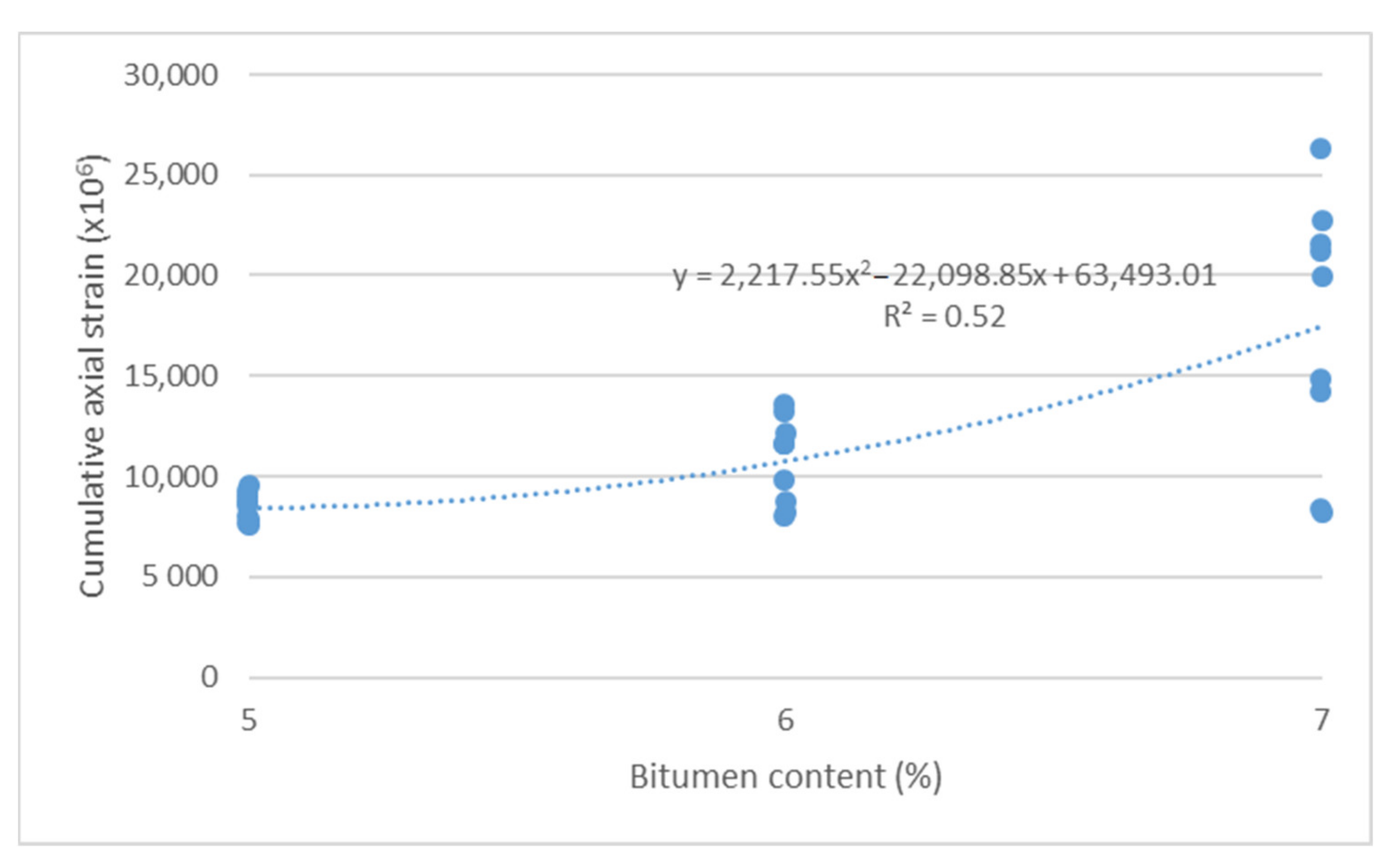
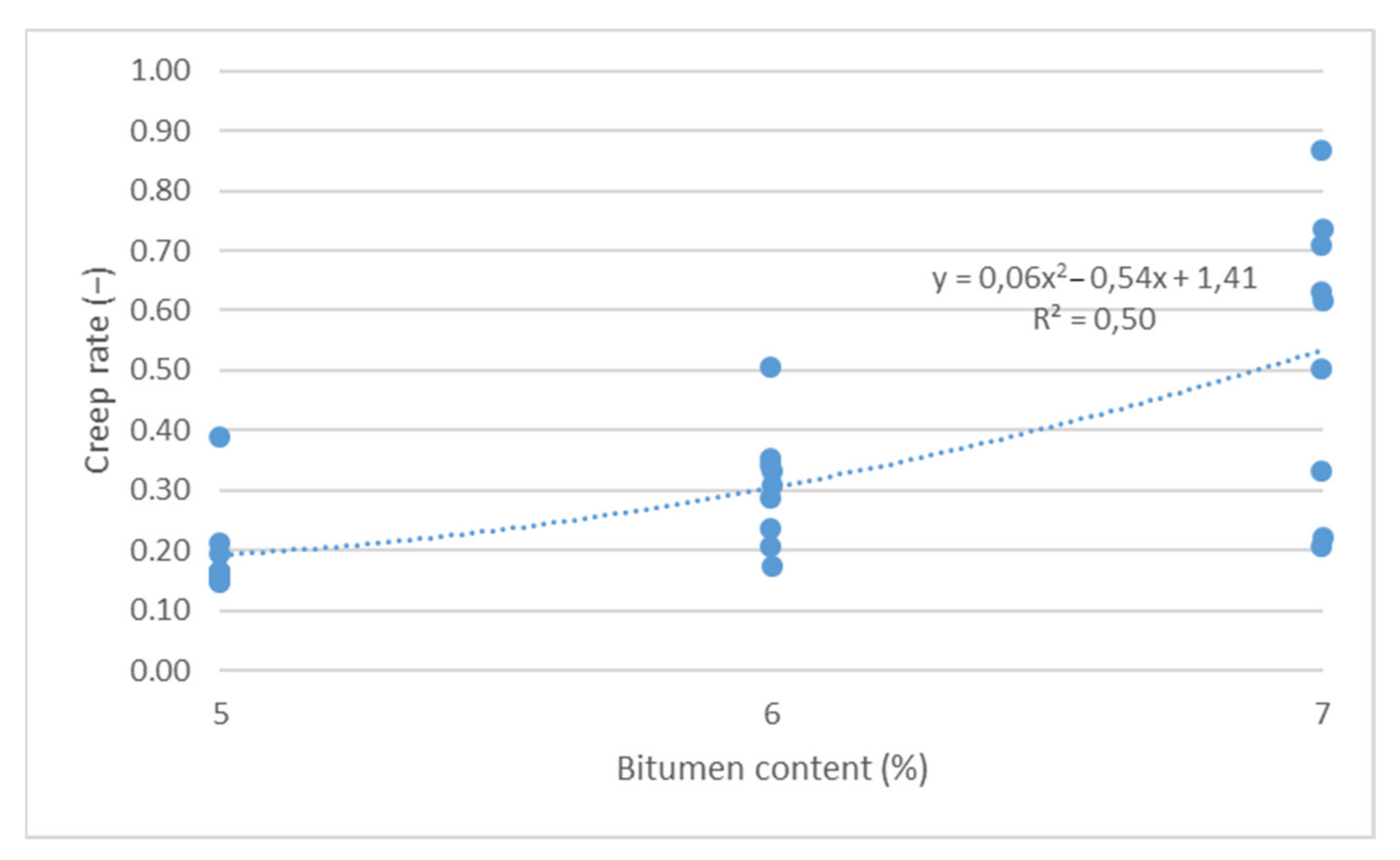
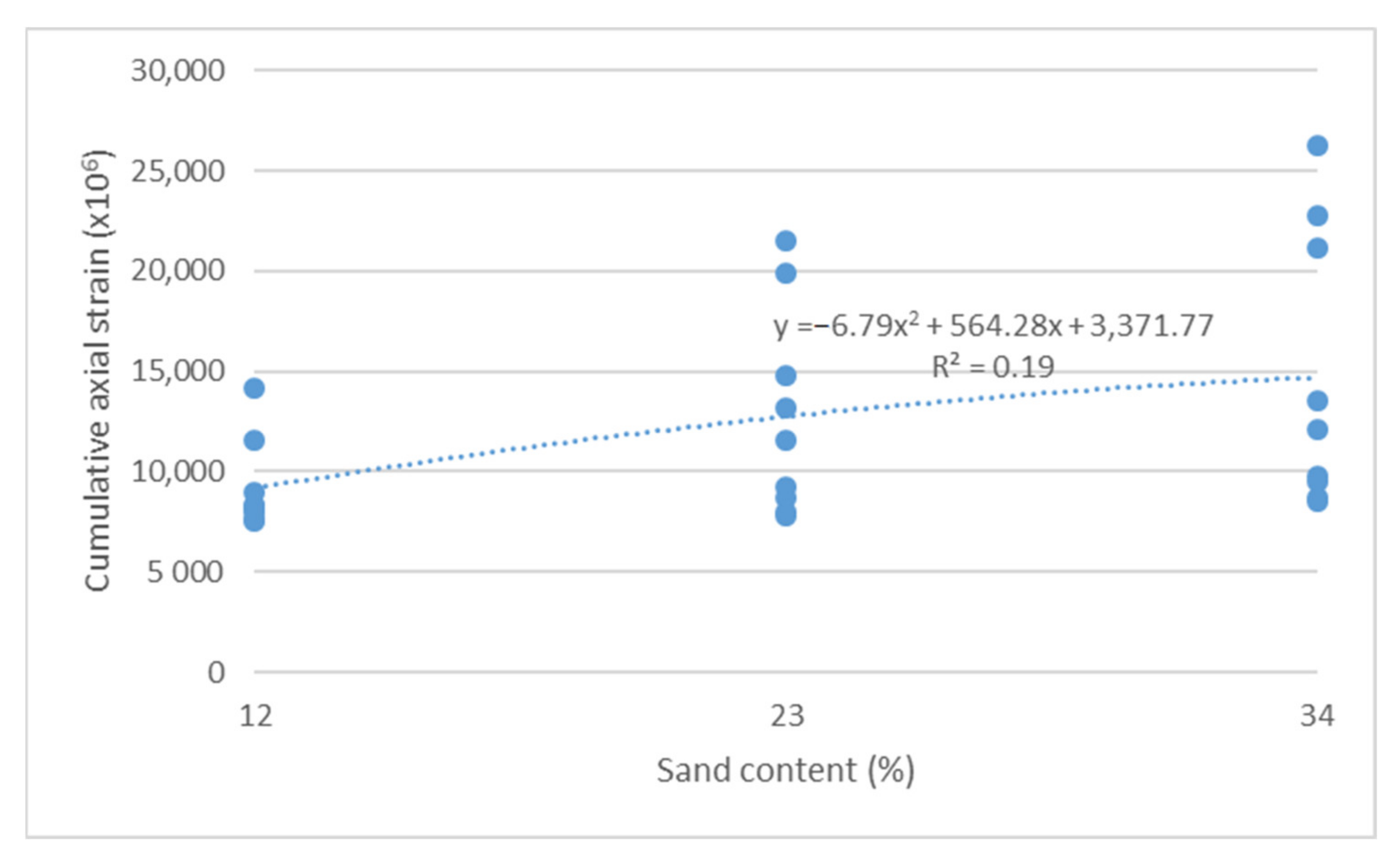

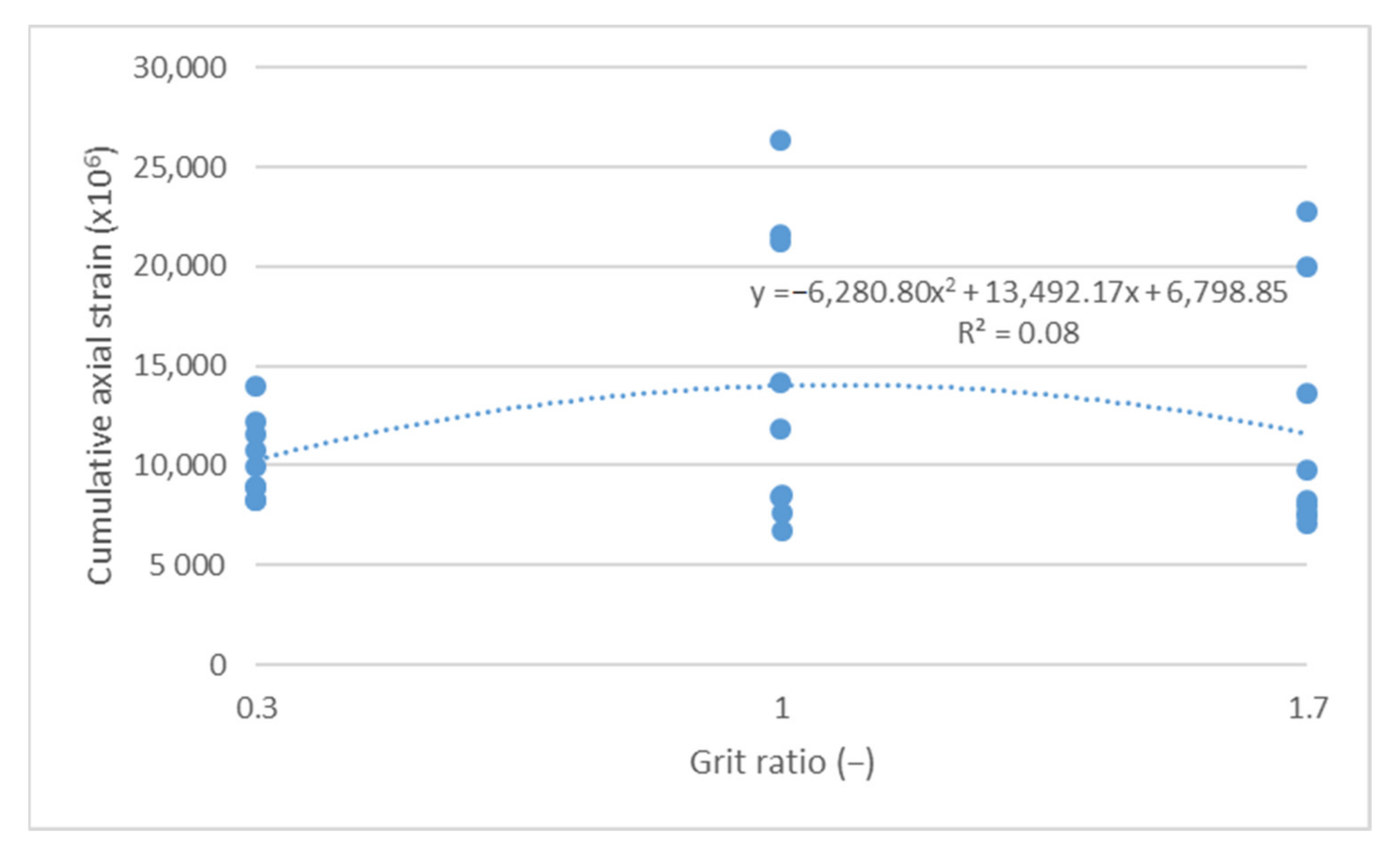
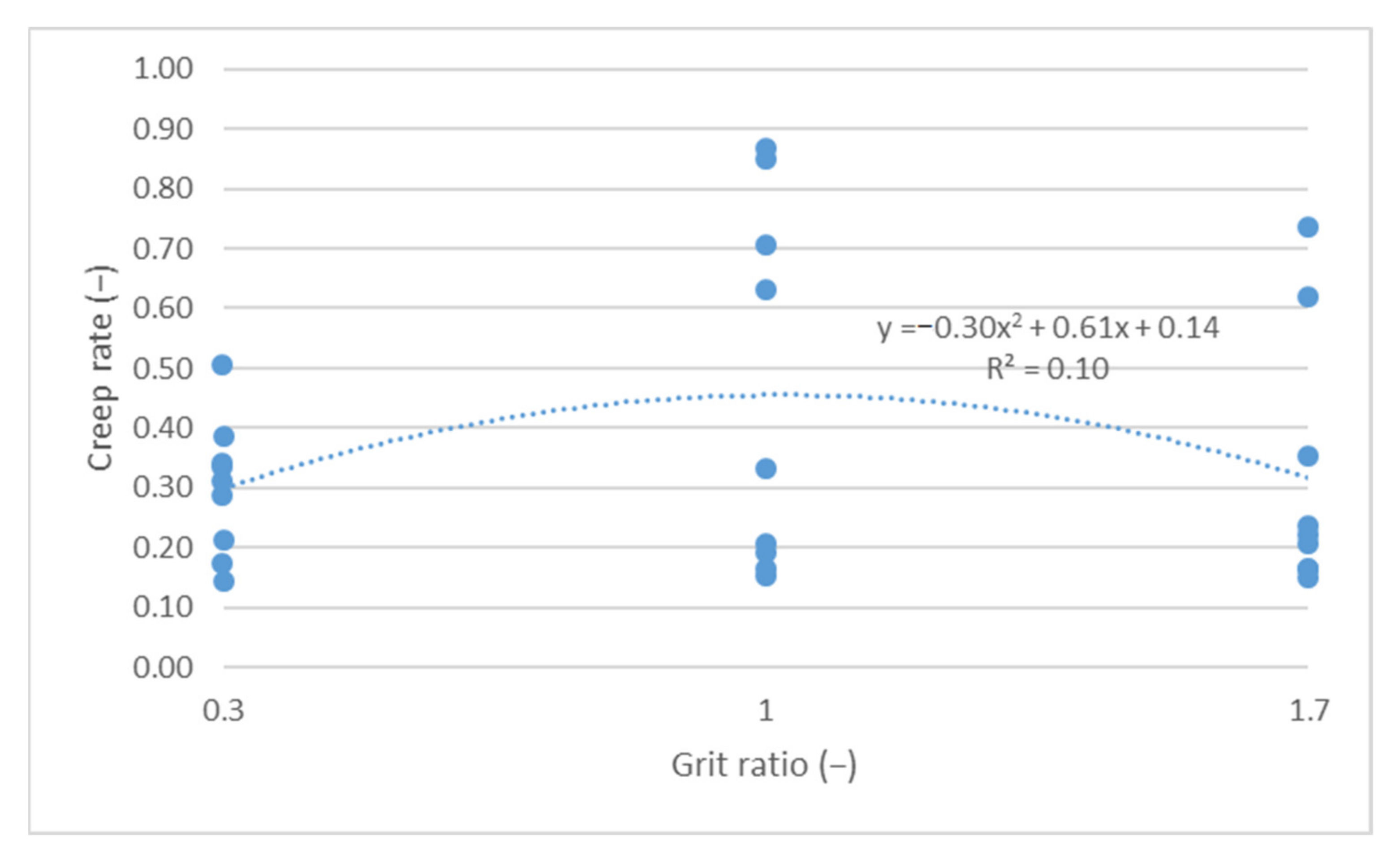

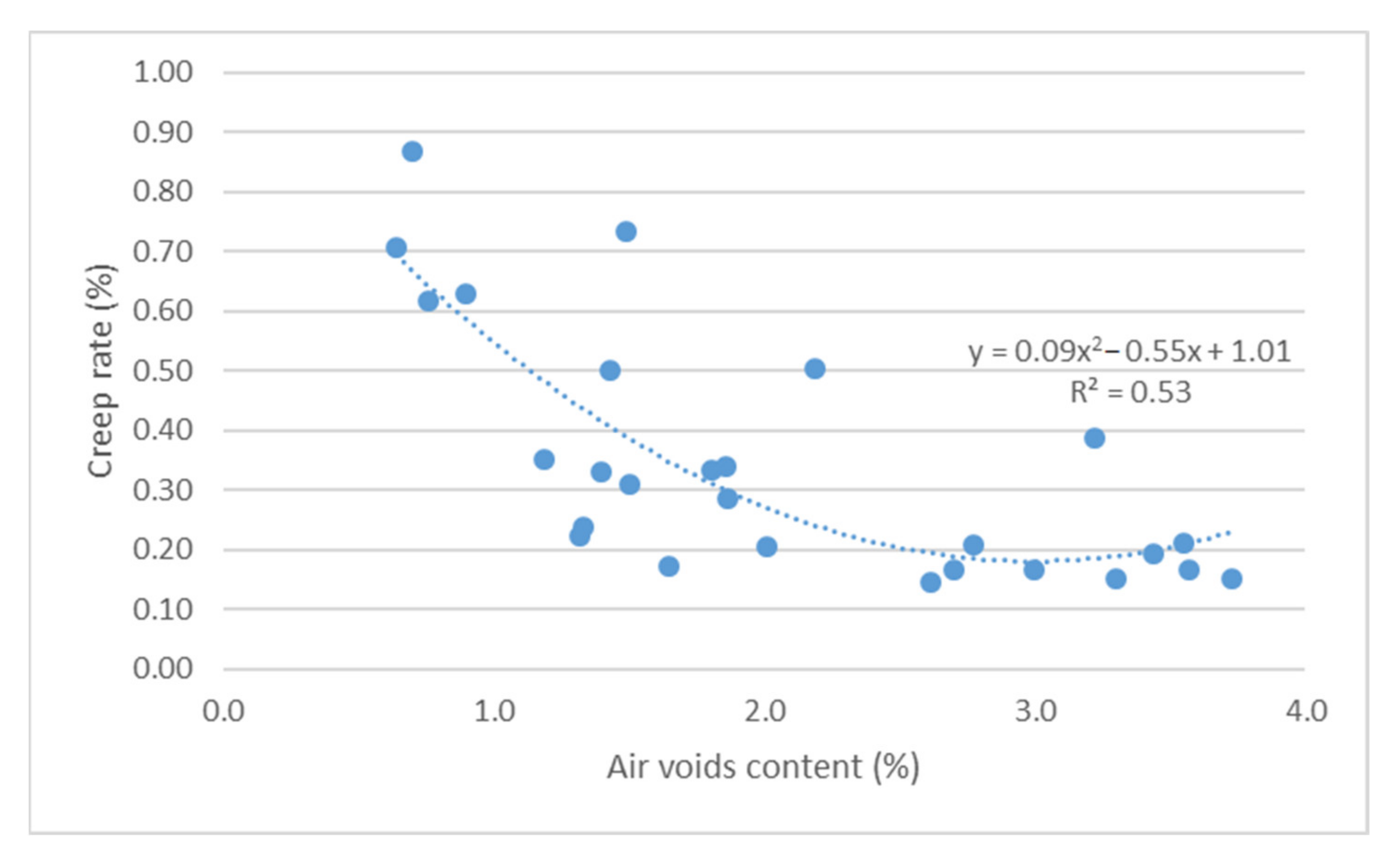
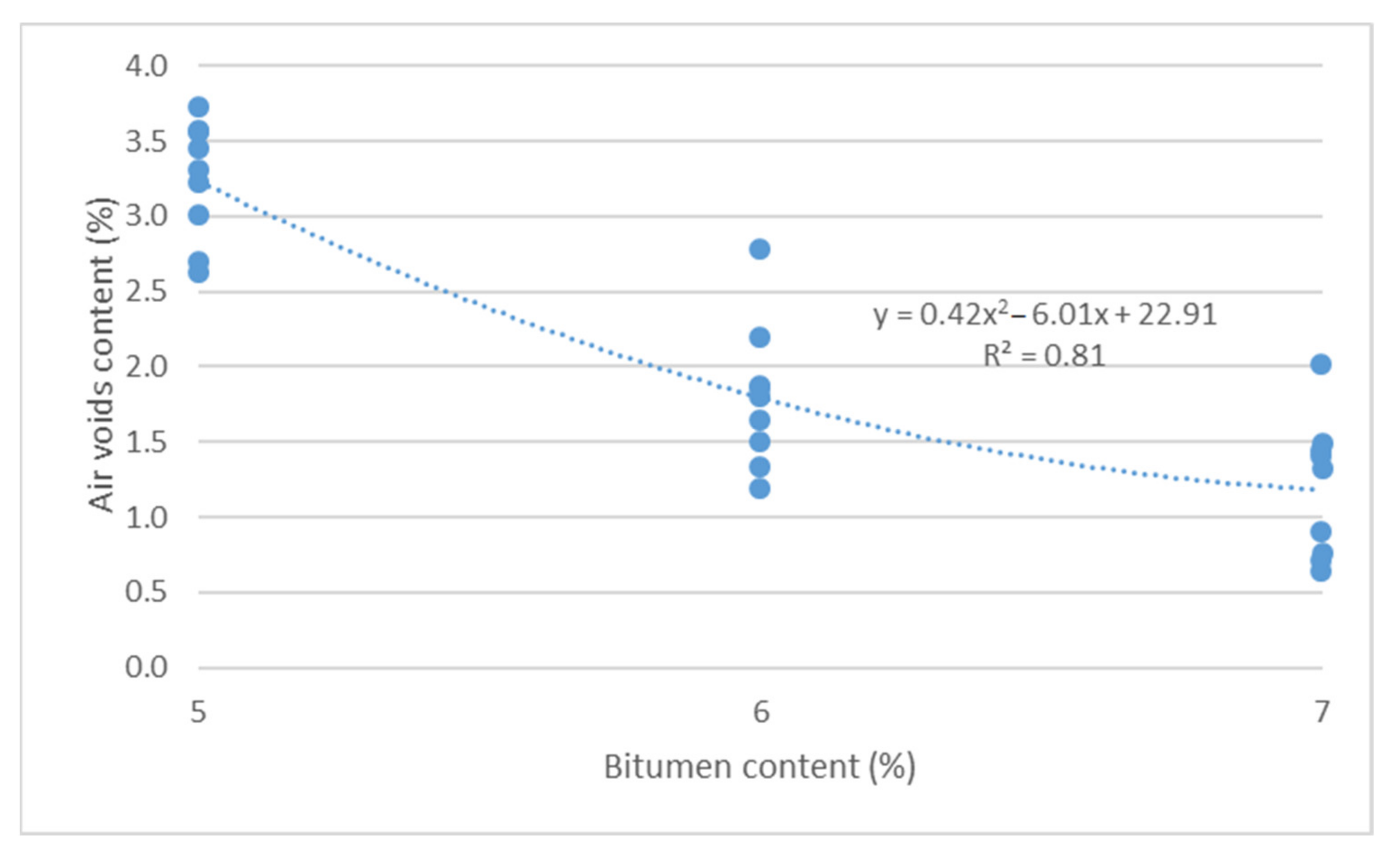
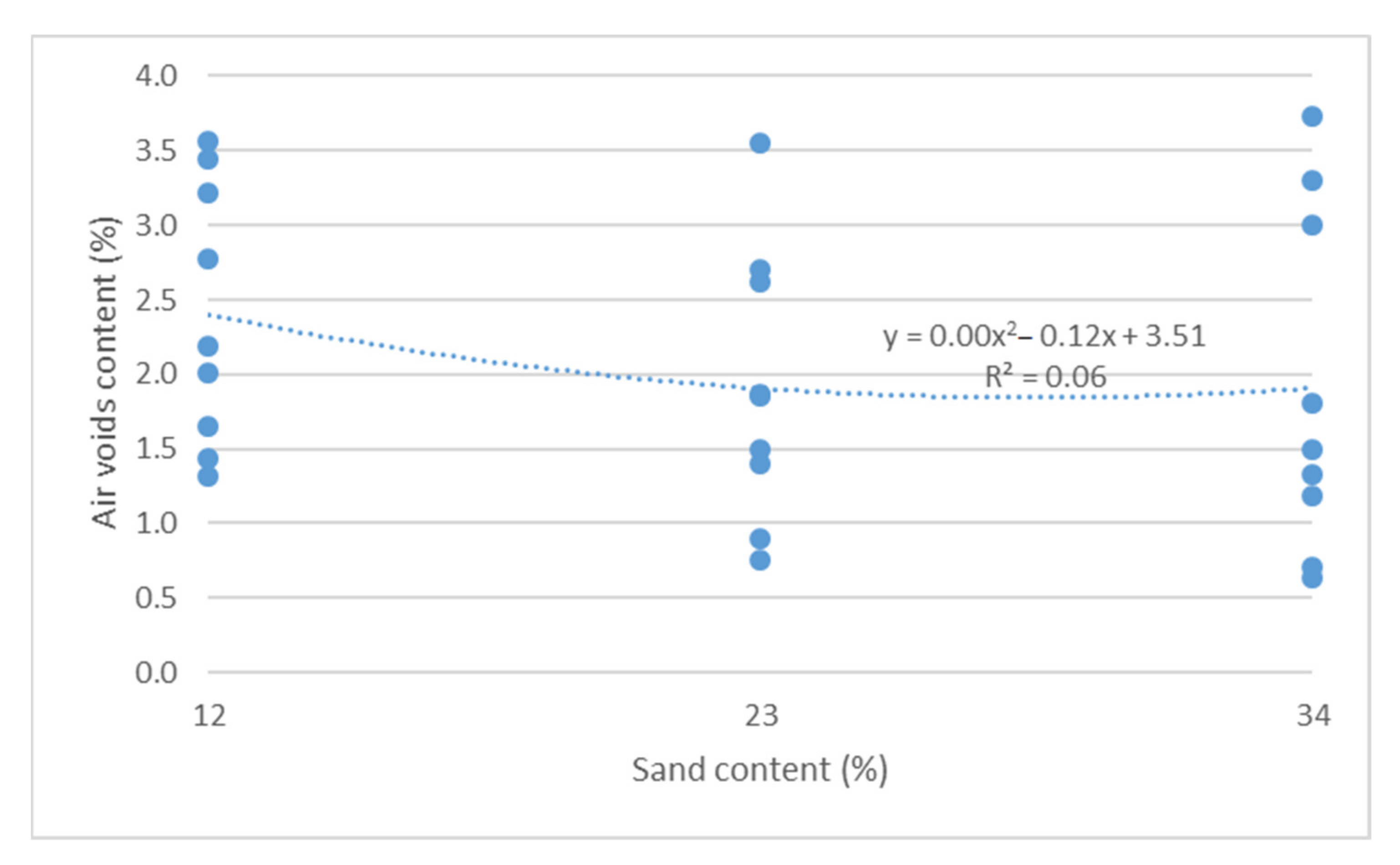
| Mixture Code | Binder Content (%) | Sand Content (%) | Grit Ratio (-) | Cumulative Axial Strain (×106) | Creep Rate (-) | Air Void Content (%) |
|---|---|---|---|---|---|---|
| 1A | 5 | 12 | 1.7 | 7544 | 0.17 | 3.6 |
| 1B | 6 | 12 | 1.7 | 8167 | 0.17 | 1.6 |
| 1C | 7 | 12 | 1.7 | 8231 | 0.22 | 1.3 |
| 2A | 5 | 34 | 0.3 | 9508 | 0.15 | 3.7 |
| 2B | 6 | 34 | 0.3 | 12,124 | 0.33 | 1.8 |
| 2C | 7 | 34 | 0.3 | 22,736 | 0.74 | 1.5 |
| 3A | 5 | 23 | 1 | 7842 | 0.17 | 2.7 |
| 3B | 6 | 23 | 1 | 8733 | 0.31 | 1.5 |
| 3C | 7 | 23 | 1 | 19,942 | 0.62 | 0.8 |
| 4A | 5 | 23 | 0.3 | 9262 | 0.21 | 3.6 |
| 4B | 6 | 23 | 0.3 | 11,600 | 0.29 | 1.9 |
| 4C | 7 | 23 | 0.3 | 14,754 | 0.33 | 1.4 |
| 5A | 5 | 12 | 0.3 | 8964 | 0.39 | 3.2 |
| 5B | 6 | 12 | 0.3 | 11,526 | 0.50 | 2.2 |
| 5C | 7 | 12 | 0.3 | 14,150 | 0.50 | 1.4 |
| 6A | 5 | 23 | 1.7 | 7967 | 0.14 | 2.6 |
| 6B | 6 | 23 | 1.7 | 13,185 | 0.34 | 1.9 |
| 6C | 7 | 23 | 1.7 | 21,537 | 0.63 | 0.9 |
| 7A | 5 | 34 | 1.7 | 8542 | 0.16 | 3.0 |
| 7B | 6 | 34 | 1.7 | 13,557 | 0.35 | 1.2 |
| 7C | 7 | 34 | 1.7 | 26,278 | 0.87 | 0.7 |
| 8A | 5 | 12 | 1 | 7591 | 0.19 | 3.4 |
| 8B | 6 | 12 | 1 | 7963 | 0.21 | 2.8 |
| 8C | 7 | 12 | 1 | 8352 | 0.21 | 2.0 |
| 9A | 5 | 34 | 1 | 8718 | 0.15 | 3.3 |
| 9B | 6 | 34 | 1 | 9733 | 0.24 | 1.3 |
| 9C | 7 | 34 | 1 | 21,171 | 0.71 | 0.6 |
| Dependent Variable | Factors | ||||||||
|---|---|---|---|---|---|---|---|---|---|
| Binder Content | Sand Content | Grit Ratio | |||||||
| r | Correlation Level | Significance | r | Correlation Level | Significance | r | Correlation Level | Significance | |
| Cumulative axial strain | 0.69 | high | p < 0.05 | 0.42 | medium | p < 0.05 | 0.03 | low | p > 0.05 |
| Creep rate | 0.68 | high | p < 0.05 | 0.25 | low | p > 0.05 | 0.08 | low | p > 0.05 |
| Dependent Variable | Factors | |||||
|---|---|---|---|---|---|---|
| Binder Content | Sand Content | Grit Ratio | ||||
| Significance (p) | Significance Level | Significance (p) | Significance Level | Significance (p) | Significance Level | |
| Air void content | 0.00 | very significant | 0.00 | very significant | 0.05 | low significance |
| Dependent Variable | Factors | |||||
|---|---|---|---|---|---|---|
| Binder Content | Sand Content | Grit Ratio | ||||
| Significance (p) | Significance Level | Significance (p) | Significance Level | Significance (p) | Significance Level | |
| Cumulative axial strain | 0.00 | very significant | 0.02 | significant | 0.48 | insignificant |
| Creep rate | 0.00 | very significant | 0.49 | insignificant | 0.36 | insignificant |
| Equation Component | Cumulative Axial Strain | Significance (p) | Creep Rate | Significance (p) |
|---|---|---|---|---|
| 84,204.6 | 0.043 | −0.784966 | 0.002 | |
| —binder content | −24,622.8 | 0.069 | 0.190305 | 0.000 |
| —binder content2 | 1839.4 | 0.098 | ||
| —sand content | −1343.4 | 0.030 | ||
| —sand content2 | −6.1 | 0.498 | ||
| —binder content × sand content | 309.0 | 0.000 | ||
| Mixture Type | Binder Content | Sand Content | Air Void Content (Calculated) | Cumulative Axial Strain (Calculated) | Creep Rate (Calculated) |
|---|---|---|---|---|---|
| PL1–SMA | 5.9 | 15 | 2.4 | 10,151 | 0.34 |
| PL2–SMA | 6.5 | 16 | 1.8 | 11,844 | 0.45 |
| PL3–AC | 5.0 | 26 | 3.3 | 12,313 | 0.16 |
Publisher’s Note: MDPI stays neutral with regard to jurisdictional claims in published maps and institutional affiliations. |
© 2021 by the authors. Licensee MDPI, Basel, Switzerland. This article is an open access article distributed under the terms and conditions of the Creative Commons Attribution (CC BY) license (https://creativecommons.org/licenses/by/4.0/).
Share and Cite
Pokorski, P.; Radziszewski, P.; Sarnowski, M. Study of High-Temperature Properties of Asphalt Mixtures Used for Bridge Pavement with Concrete Deck. Materials 2021, 14, 4238. https://doi.org/10.3390/ma14154238
Pokorski P, Radziszewski P, Sarnowski M. Study of High-Temperature Properties of Asphalt Mixtures Used for Bridge Pavement with Concrete Deck. Materials. 2021; 14(15):4238. https://doi.org/10.3390/ma14154238
Chicago/Turabian StylePokorski, Piotr, Piotr Radziszewski, and Michał Sarnowski. 2021. "Study of High-Temperature Properties of Asphalt Mixtures Used for Bridge Pavement with Concrete Deck" Materials 14, no. 15: 4238. https://doi.org/10.3390/ma14154238
APA StylePokorski, P., Radziszewski, P., & Sarnowski, M. (2021). Study of High-Temperature Properties of Asphalt Mixtures Used for Bridge Pavement with Concrete Deck. Materials, 14(15), 4238. https://doi.org/10.3390/ma14154238






